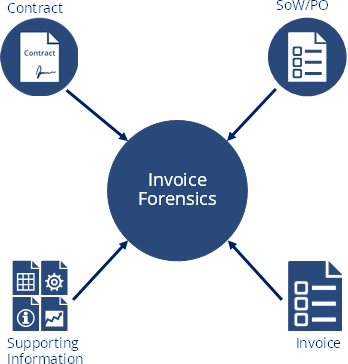In today’s dynamic business landscape, managing vendor relationships and ensuring financial accuracy pose significant challenges. With so many invoices, complex contracts and manual processes to manage, enterprises often overpay without realizing it. Invoice forensics is a solution that ensures the accuracy of historical invoices and can uncover cost credits of up to 10% of the annual value of the contract.
Let’s explore the hurdles companies face in invoice validation, the benefits of embracing invoice forensics, and how it can pave the way to a more effective and proactive approach to financial governance.
Why Is Invoice Validation So Challenging?
Inadequate invoice management doesn’t necessarily result from a lack of effort or lack of desire for accuracy on the part of the enterprise buyer. The sheer volume of invoices, disparate contractual terms, resource limitations and manual validation processes create obstacles to maintaining accuracy, compliance and efficiency in invoice management.
Enterprise ecosystems are typically made up of a multitude of vendors with complex contracts. Many rely on entry-level positions to perform manual invoice validation, which is slow and prone to human error. These resources may not have a comprehensive understanding of the service provider contracts. And contractual agreements often contain complex financial and legal details beyond what may be validated in the fees section of the invoices.
When invoices are not reviewed or reconciled regularly, there is a greater potential for discrepancies and value leakage. Without strong governance processes and sufficient automation, companies frequently overlook or fail to ensure compliance with important contractual provisions such as volume discounts, COLA, unutilized project pools/innovation funds and the correct methodology to bill resource units.
Innovation management is another contractual provision that is commonly overlooked, even when contracts contain an innovation fund. Enterprises often lack the capacity or budget to track the activities to completion, or more importantly, fully integrate them into their operations. Invoice forensics can help companies identify unused innovation dollars, which can be used to pay for the direct cost of incorporating these enhancements into the business. By looking closely at paid invoices, enterprises can unlock hidden value and apply these credits towards innovative solutions and improved governance.
The Benefits of an Invoice Forensics Process that Scrubs Your Invoice Data
A thorough exploration of your invoice data will have the benefit of cutting spending and optimizing costs without sacrificing the quantity or quality of your existing services. All too often, companies are unknowingly overpaying their service providers. By engaging an unbiased third party to look into invoice management, you gain a fresh perspective on your review process and add a level of assurance that you are being billed appropriately. With a solution like this, there is no financial risk since these engagements are based on a gainshare model – i.e., if no discrepancies are found, you are not charged.
Within just 8-12 weeks, a company will see greater accuracy with a four-way data match methodology that uses the service agreement as the source of truth and reconciles it with purchase orders/change requests, invoices and supporting documentation.
True invoice forensics uses a four-way data validation method that also calculates “contracted resource” utilization.

How Invoice Forensics Can Evolve into a Robust Governance Model
An invoice forensics initiative can play an important role in the planning and development of an effective governance model, complete with data analytics and automation. Here’s an example. A global 1000 company needed to ensure it wasn’t overpaying its service providers. After careful consideration of the environment and close scrutiny of the company’s supplier invoices, we identified several instances in which the company was overpaying for managed services. In a vendor management organization (VMO) preparedness workshop, ISG delivered a gap analysis on the findings and crafted a customized governance strategy with a few different implementation options. The company chose to use the savings identified through invoice forensics to implement VMO as a Service (VMOaaS), recognizing it as the most efficient option with immediate value.
Using ISG’s holistic supplier and contract management offering, VMOaaS, and powered by our GovernX platform, the company was able to use data analytics and automated workflows to manage not only invoices, but also track SLAs, contract deliverables and obligations, innovation spend and SOW approvals. This provided complete visibility into the entire vendor ecosystem and ensured the company would get the most out of the services it was paying for.
By revealing inefficiencies in the validation process and identifying cost savings, invoice forensics is the first step in developing and even funding a better governance strategy. When invoice forensics is supplemented by a mature supplier governance organization, enterprises become more proactive and holistic in how they manage their service provider ecosystem. This transformational approach provides additional value and visibility through centralized governance, cost optimization, risk mitigation, enhanced collaboration and innovation.
Find out more about how we do invoice forensics here and our Supplier & Contract Management advisory here. And contact us to discuss how we can help you.
